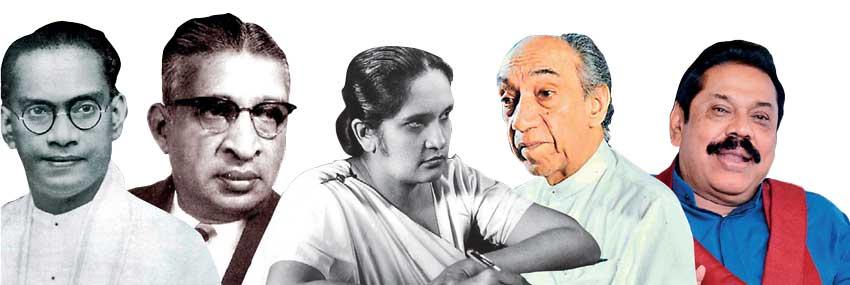Reply To:
Name - Reply Comment
Last Updated : 2024-04-19 19:28:00

The conventional view that the lower middle class have traditionally been supportive of either the UNP or SLFP does not bear out their electoral preferences after 1956
Not since 1988 has an election prophesied the coming to power of populists from both political parties
Cardinal Malcolm Ranjith’s apparently populist pleas channel the grievances of the Catholic underclass: the Sinhala speaking Catholic belt from Negombo to Moratuwa
 The 1956 election did not just spell out a victory for socialism. The rural peasantry won mainly, if not mainly hands down, because the petty bourgeoisie who led the revolution that culminated in 1956 looked to nationalism and socialism, both of which happened to suit the (predominantly) Sinhala Buddhist peasantry, who made up the most discriminated ethnic group in the island after plantation Tamil workers. Denzil Pieris referred to that year’s election outcome as “the maturing of the long submerged Sinhalese intelligentsia”, only one group of which was the working class, and Martin Wickramasinghe referred to it as the fall of the bamunu kulaya. The organisers in the SLFP, attempting to redress a historical wrong, became leaders of groups that had suffered from restrictive colonial policies. They put Bandaranaike to power.
The 1956 election did not just spell out a victory for socialism. The rural peasantry won mainly, if not mainly hands down, because the petty bourgeoisie who led the revolution that culminated in 1956 looked to nationalism and socialism, both of which happened to suit the (predominantly) Sinhala Buddhist peasantry, who made up the most discriminated ethnic group in the island after plantation Tamil workers. Denzil Pieris referred to that year’s election outcome as “the maturing of the long submerged Sinhalese intelligentsia”, only one group of which was the working class, and Martin Wickramasinghe referred to it as the fall of the bamunu kulaya. The organisers in the SLFP, attempting to redress a historical wrong, became leaders of groups that had suffered from restrictive colonial policies. They put Bandaranaike to power.
These leaders were by no means retrogressive, but in their clamour to have the cake and eat it too – to overthrow the existing order, and enjoy the spoils of the new order – they inevitably turned to right-wing politics that could ensure both. They were, as Mervyn de Silva called them, “both a shaper and filter of opinion”, and for that reason formed a buffer between elites and masses that was barely noticed, rarely pacified, but made full use of when elections were around the corner. If that sounds like what’s happening today, it’s because it IS happening today.
The conventional view that the lower middle class have traditionally been supportive of either the UNP or SLFP does not bear out their electoral preferences after 1956. They were responsible for S. W. R. D. Bandaranaike’s victory in the fifties, Dudley Senanayake’s return in the sixties, Sirimavo Bandaranaike’s return in the seventies, and J. R. Jayewardene’s victories in the eighties (all the way to Mahinda Rajapaksa’s defeat and subsequent resurgence today).

The list goes on and on. The closed economy was as much a product of this class as was the open economy 20 years later. The war was as much a product as was the end of it 30 years later. If politics is about Tweedledum turning into Tweedledee, in Sri Lanka that process has been the result of the contradictory positions taken by this middle class; consider, among many other such paradoxes they are heir to, that many of the stalwarts of the (largely) petty bourgeois Jathika Hela Urumaya have now found a roost in the unlikeliest of places: the UNP.
Not since 1988 has an election prophesied the coming to power of populists from both political parties. Sajith Premadasa may not be the sort of populist-nationalist-pragmatist his father was and the Southern born Rajapaksas are, but to date he is the only popular option from the UNP (which says a lot about the UNP and those who vote for it). A comment on Facebook I read the other day, claiming that Sajith does not have the kind of class that Ranil and, to a lesser extent, Karu Jayasuriya have, indicates the depths of classism to which the traditional town dwelling UNPer can dive even if, and when, the UNP’s Working Committee is pushing the Sajith factor forward. Such commentators are misreading the mood of the moment, and the impact the April 21 attacks have had on the Sinhala (Buddhist and Catholic) lower middle class.
It’s interesting to note that Cardinal Malcolm Ranjith’s apparently populist pleas channel the grievances of the Catholic underclass: the Sinhala speaking Catholic belt from Negombo to Moratuwa, just as the Buddhist clergy’s calls to arms against Muslim shops, Muslim doctors, and so on targeted the Buddhist petty bourgeoisie in the village and the city. It’s also interesting to note that the image of the Cardinal among the wealthier Catholics is very different to his image among the Catholic underclass, and that the former claim that he’s doing more harm than good by his statements. It’s the same attitude prevalent among English speaking Buddhists: they insist on monks restricting themselves to preaching bana at their monasteries.
Here the problem is that the remedy offered by those opposed to populist nationalism is as hollow and obscure as what they oppose. Those who idealise the indigenous are more often than not entranced by the non-indigenous and the Western, and those who idealise the non-indigenous and the Western tend to be vitriolic in their criticisms of the indigenous. The latter are, to be sure, as narrow minded as the former, but with one important caveat: those who tend to valorise the indigenous are more in tune with what’s happening on the ground, and their observations about their heritage are not as mythical as their opponents like to claim; who, after all, can listen to Professor Raj Somadeva’s views about pre-colonial Sri Lanka, and not disagree?
Like I’ve written in this column before, the one does not presume the negation of the other: nationalism doesn’t have to be the opposite of cosmopolitanism, and cosmopolitanism doesn’t have to be the opposite of nationalism. At one point, the Left, especially the Trotskyites, played with both, and opposed on every point the idea of a Sri Lanka run along bourgeois and petty bourgeois values. They opposed “Sinhala Only”, but also opposed conducting public and police affairs in English; they opposed the “Sinhalisation” of the flag, but also opposed continuing as a Dominion; they opposed the disenfranchisement of Tamil plantation workers, but also opposed dividing the country into two on the basis of language and ethnicity.
In other words, before their compromises with establishment politics, they were for both Sinhale and non-Sinhale. Unfortunately, the leadership of the populist revival fell on the Sinhala middle class: the five great forces. In colonial societies intermediate classes, if they suffer economically and culturally from colonial policies, take up arms against the established order.
The extent to which such a social class take up arms depends on two factors: how far they were allowed to develop under colonial rule, and how far the bourgeoisie were allowed to rise over them. In Sri Lanka, unlike in India, populism became the preserve of the petty bourgeoisie, who were empowered because the upper classes didn’t form a militant anti-imperialist bourgeoisie and thus left a cultural void. India in fact became one of the few countries in the colonised world that became what Michał Kalecki called an “intermediate regime”, led by the lower middle class and rich peasantry. Sri Lanka became such a regime only a decade after it gained independence, by which time severe populist pressures had built up. The African revolutionary Amilcar Cabral contended that populism of this sort could, would, and should morph into a liberation movement. Here, however, the intermediates who led the populist revolt led it from the cultural front, and were incapable of leading a more comprehensive movement.
The Sinha Le campaign and the movement against Muslim shops are two of many manifestations of the discontent of this underprivileged yet populous class; they lash out against the Other in terms of works of art, protests, and populist, racist slogans, but without going as far as to demand an autarky shut out from the rest of the world. Put in another way, they are anti-Muslim and anti-Western, but at the same time embrace Western social and cultural patterns. What differentiates them from the Westernised haute bourgeoisie – the sort who claimed they were not for Ranil but for democracy when they demonstrated against Mahinda Rajapaksa being sworn in as the Prime Minister last October – is that they are less organised and more splintered.
And yet, despite their lack of unity, to date this section of the middle class have benefited the most from social change, in a context where social change has invariably meant the overthrow of an order based on a Westernised, de-nationalised elite in favour of one based on tighter national security and wider economic opportunity. That these policies have entrenched an intermediate class has been borne out not by election results, but by the compromises made by both political establishments – the UNP and the SLFP – as well as third force parties – the Old Left and the JVP, though not the Frontline Socialists – to accommodate their populist pressures.
Marx and Engels treated this class with caution: they realised that though it could support the overthrow of the old order, it could not be counted on for long to consolidate the gains of the revolution. The nationalists of today are playing with fire when they channel its grievances to achieve petty political ends, particularly considering the impact the April 21 attacks had on it. The sooner we realise that this class looks no further than their entrenchment, the sooner we will realise that the way forward for the country is a vision which consolidates and strives to fulfil the aspirations of the peasantry and proletariat. The populists will not deliver that vision, and neither will those who oppose the populists. Clearly, then, we need to look elsewhere.
UDAKDEV1@GMAIL.COM

Add comment
Comments will be edited (grammar, spelling and slang) and authorized at the discretion of Daily Mirror online. The website also has the right not to publish selected comments.
Reply To:
Name - Reply Comment
On March 26, a couple arriving from Thailand was arrested with 88 live animal
According to villagers from Naula-Moragolla out of 105 families 80 can afford
Is the situation in Sri Lanka so grim that locals harbour hope that they coul
A recent post on social media revealed that three purple-faced langurs near t